
Sintra is a town and municipality in the Greater Lisbon region of Portugal, located on the Portuguese Riviera. The population of the municipality in 2011 was 377,835, in an area of 319.23 square kilometres (123.26 sq mi). Sintra is one of the most urbanized and densely populated municipalities of Portugal and hosts several cities albeit the seat of the municipality is the town of Sintra proper. A major tourist destination famed for its picturesqueness, the municipality has several historic palaces, castles, scenic beaches, parks and gardens.
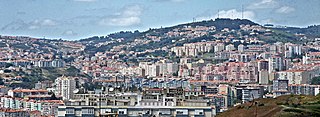
Odivelas is a city and a municipality in Lisbon metropolitan area, Portugal, in the Lisbon District and the historical and cultural Estremadura Province. The municipality is located 10 km northwest of Lisbon. The present Mayor is Hugo Martins, elected by the Socialist Party. The population in 2011 was 144,549, in an area of 26.54 km2 (10.25 sq mi).

Grallator ["GRA-luh-tor"] is an ichnogenus which covers a common type of small, three-toed print made by a variety of bipedal theropod dinosaurs. Grallator-type footprints have been found in formations dating from the Early Triassic through to the early Cretaceous periods. They are found in the United States, Canada, Europe, Australia, Brazil and China, but are most abundant on the east coast of North America, especially the Triassic and Early Jurassic formations of the northern part of the Newark Supergroup. The name Grallator translates into "stilt walker", although the actual length and form of the trackmaking legs varied by species, usually unidentified. The related term "Grallae" is an ancient name for the presumed group of long-legged wading birds, such as storks and herons. These footprints were given this name by their discoverer, Edward Hitchcock, in 1858.

Municipium Cives Romanorum Felicitas Julia Olisipo was the ancient name of modern-day Lisbon while part of the Roman Empire.

The Praça do Comércio is a large, harbour-facing square in Portugal's capital, Lisbon.
Dr. Miguel Telles AntunesGOIH is a famous Portuguese academic, specializing in paleontology, zooarchaeology, and geology. Antunes is a ranking member of various institutions, including the Lisbon Academy of Sciences, Nova University of Lisbon, and the Lourinhã Museum of Ethnology and Archaeology.
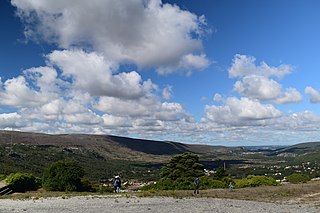
Serras de Aire e Candeeiros Natural Park (PNSAC) is a natural park in Portugal. It is one of the 30 areas which are officially under protection in the country. It is the most important repository of limestone formations in Portugal.
The Protected areas of Portugal are classified under a legal protection statute that allows for the adequate protection and maintenance of biodiversity, while providing services for ecosystem that maintains the natural and geological patrimony.

The Calcarios Micriticos da Serra de Aire is a Bathonian geologic formation in Portugal. Fossil sauropod tracks have been reported from the formation.
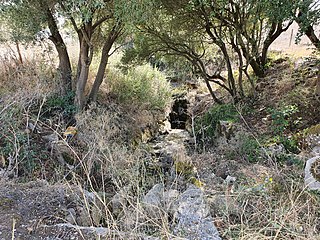
The archaeological site of Colaride, is a Roman necropolis in a natural cave, located in the Portuguese civil parish of Agualva e Mira-Sintra, municipality of Sintra.
The Sintra Natural History Museum is a museum of natural history located in the historic center of the village of Sintra. The museum has both at national and international level due to the quality and rarity of many of its exhibits.
The following is a timeline of the history of the city of Lisbon, Portugal.

Paleontology in Colorado refers to paleontological research occurring within or conducted by people from the U.S. state of Colorado. The geologic column of Colorado spans about one third of Earth's history. Fossils can be found almost everywhere in the state but are not evenly distributed among all the ages of the state's rocks. During the early Paleozoic, Colorado was covered by a warm shallow sea that would come to be home to creatures like brachiopods, conodonts, ostracoderms, sharks and trilobites. This sea withdrew from the state between the Silurian and early Devonian leaving a gap in the local rock record. It returned during the Carboniferous. Areas of the state not submerged were richly vegetated and inhabited by amphibians that left behind footprints that would later fossilize. During the Permian, the sea withdrew and alluvial fans and sand dunes spread across the state. Many trace fossils are known from these deposits.

Paleontology in Utah refers to paleontological research occurring within or conducted by people from the U.S. state of Utah. Utah has a rich fossil record spanning almost all of the geologic column. During the Precambrian, the area of northeastern Utah now occupied by the Uinta Mountains was a shallow sea which was home to simple microorganisms. During the early Paleozoic Utah was still largely covered in seawater. The state's Paleozoic seas would come to be home to creatures like brachiopods, fishes, and trilobites. During the Permian the state came to resemble the Sahara desert and was home to amphibians, early relatives of mammals, and reptiles. During the Triassic about half of the state was covered by a sea home to creatures like the cephalopod Meekoceras, while dinosaurs whose footprints would later fossilize roamed the forests on land. Sand dunes returned during the Early Jurassic. During the Cretaceous the state was covered by the sea for the last time. The sea gave way to a complex of lakes during the Cenozoic era. Later, these lakes dissipated and the state was home to short-faced bears, bison, musk oxen, saber teeth, and giant ground sloths. Local Native Americans devised myths to explain fossils. Formally trained scientists have been aware of local fossils since at least the late 19th century. Major local finds include the bonebeds of Dinosaur National Monument. The Jurassic dinosaur Allosaurus fragilis is the Utah state fossil.
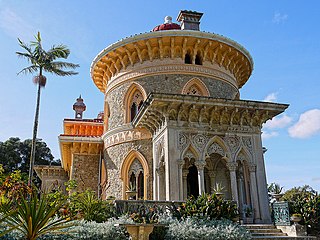
The Portuguese Riviera is the affluent coastal region to the west of Lisbon, Portugal, centered on the coastal municipalities of Cascais, Estoril, and Sintra. It is coterminous with the Estoril Coast and occasionally known as the Costa do Sol. The region is internationally known as a luxury destination for its history as a home of the wealthy, the famous, and European royalty. Both Cascais and Sintra consistently rank among the richest municipalities in Portugal.
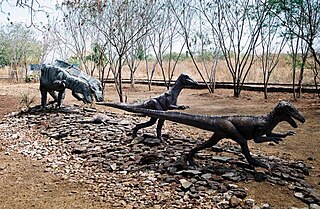
The Valley of the Dinosaurs is an area in the state of Paraíba, Brazil, that contains many fossilized dinosaur tracks. It contains the Valley of the Dinosaurs Area of Relevant Ecological Interest, a sustainable use area of relevant ecological interest. This in turn contains the smaller and fully protected Valley of the Dinosaurs Natural Monument. In 2015–16 there was concern that renovations to the tourist attraction, which had been delayed through lack of funding, might not be respecting the integrity of the site.
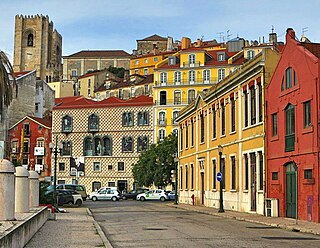
Lisbon is one of the most popular city destinations in Europe. The city of Lisbon and the Lisbon metropolitan area attracts a significant number of tourists each year, drawn to its historical and cultural heritage, good transportation connections and good touristic infrastructure.

Ruy Roque Gameiro (27 February 1906 – 18 August 1935) was a Portuguese sculptor. Although he died relatively young, he won the admiration of critics, particularly José de Figueiredo.

Pegadas de Dinossáurios da Serra de Aire Natural Monument is a natural monument in the Serras de Aire e Candeeiros Natural Park known for its sauropod tracks. It has the single longest known sauropod track in the world. It is part of the Calcários Micríticos formation.
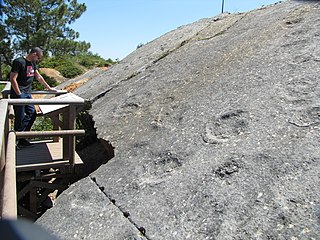
Pedreira do Avelino is a natural monument in Zambujal, Sesimbra, Portugal. The site contains an important set of dinosaur footprints from the Upper Jurassic. The main slab is about 15 metres (49 ft) long by 10 metres (33 ft) wide, and is inclined (30°), which facilitates its observation and pedagogical use. It contains 5 tracks and 108 total footprints.


















